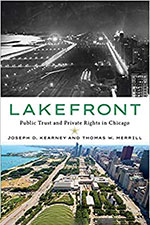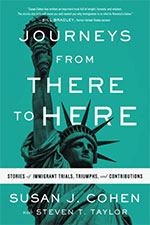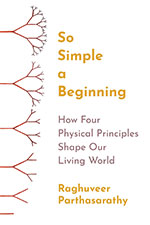 VERDICT: Touchdown!
VERDICT: Touchdown!
Lakefront: Public Trust and Private Rights in Chicago
By Joseph D. Kearney & Thomas W. Merrill (Ithaca, NY: Cornell Univ. Press, 2021). 392 pgs. $34.95. Order, www.cornellpress.cornell.edu.
Reviewed by Paul G. Kent
As a history buff and water law practitioner, I found this book to be a fascinating story. But even for people for whom terms like “accretion” are not part of their practice, this book still is a great read. (For readers not familiar with his name, coauthor Joseph D. Kearney is dean of the Marquette University Law School, Milwaukee.)
It is of course about Chicago. There are the expected intrigues among various colorful local characters, the railroads, state and local politicians, and wealthy property owners. There is also the sweep of nearly 200 years of history. The book begins in the 1850s, when Michigan Avenue was actually on Lake Michigan. Along the way there are the Chicago fire, the Columbian Exposition, the diversion of the Chicago River, and most recently the development of Millennium Park.
Today, the city of Chicago has one of the largest urban waterfront parks in the world. How did that emerge from all the bustling commercial interests in Chicago? In attempting to answer that question, the book looks at the role played by various laws, including the public trust doctrine, in shaping this development. It also highlights the many commercial, political, and personal interests that played a role, often notwithstanding the law. In many cases, uncertainty in the law has had the greatest effect on development. In this sense, the book provides insights beyond the specific laws and circumstances of the Chicago lakefront. Real estate practitioners, municipal attorneys, and environmental advocates and others can all learn lessons from this history.
The book reads like a biography and provides great detail about the key people and places. Fortunately, it also has an abundance of maps and photographs to help readers picture the places being described. And for those interested in additional information, the book has over 50 pages of detailed footnotes.
So just how much influence did the public trust doctrine have on the development of the Chicago lakefront? You will have to read the book to find out.
Paul G. Kent, U.W. 1981, practices with Stafford Rosenbaum LLP, Madison, in administrative and local government law and environmental law. He is the author of Wisconsin Water Law in the 21st Century.
 VERDICT: Not for Me, Maybe for You
VERDICT: Not for Me, Maybe for You
Journeys from There to Here: Stories of Immigrant Trials, Triumphs, and Contributions
By Susan J. Cohen with Steven T. Taylor (Austin, TX: River Grove Press, 2021). 190 pgs. $15.19. Order, www.amazon.com.
Reviewed by Susan M. Caldwell
In Journeys from There to Here, Susan J. Cohen, an experienced attorney with more than 30 years of practice in immigration law, sets forth stories regarding the immigration experiences of 11 clients. While the accounts are interesting, especially to those who enjoy historical pieces of literature, Cohen’s political views are quite pervasive and can be annoying at times depending on the reader’s point of view. Further, the book reads more like a career autobiography than a group of legal strategies.
That being said, Cohen does have an easy writing style and the book is less than 200 pages, so it is a quick read. Several of the accounts are indeed poignant and complex tales of governmental bureaucracy, prejudice, and violence. Yet, each one is an example of the strength of the human spirit and its ability to survive.
Want to Review a Book?
Please request a book and writing guidelines from Wisconsin Lawyer managing editor Karlé Lester, at klester@wisbar.org. Reviewers may keep the book reviewed. Reviews of about 500 words are due within 45 days of receiving the book. Reviews are published, space permitting, in the order received and may be edited for length and clarity.
This is not a book for readers looking for an account of legal theories in immigration law; there is little practical advice concerning that topic. However, if you are looking for true accounts of the struggles and resilience of many immigrants written by a lawyer who had a front-row seat, this might be a book for you.
Perhaps I expected something different from the book than the author intended. It occurs to me that her exact intent was not to write an instructional piece but to tell the stories of these amazing and courageous immigrants and their contributions to global society.
If that was her objective, she absolutely achieved it.
Susan Caldwell is a vice president and assistant general counsel for Madison National Life Insurance Co., a wholly owned subsidiary of Horace Mann. She holds a BA in history from U.W.-Madison and a JD from the U.W. Law School. She has more than 40 years of experience in insurance law and lives in Merrimac, Wis., with her dog, Bella.
 VERDICT: It’s A Keeper
VERDICT: It’s A Keeper
So Simple a Beginning: How Four Physical Principles Shape Our Living World
By Raghuveer Parthasarathy (Princeton, NJ: Princeton Univ. Press, 2022). 336 pgs. $35. Order, www.amazon.com.
Reviewed by Richard Ebbott
All knowledge is useful, and this book has a ton and a half of it packed into its 275 pages. The author has combined his field of physics with that of cellular biology into a new field that he calls biophysics. The result is a journey inside the cells of all living things to an understanding of DNA and four basic principles of physics that govern each cell’s growth into whatever living thing it is meant to be.
A caution from this reviewer: If you’re not that into biology, particularly DNA, skim through the first few chapters to get a basic understanding of the terminology. But if this is your field of interest, go for it. This book lays it all out in detail, and the author has included dozens of his own hand-drawn and hand-painted illustrations.
Consider one cell of any living thing. As it divides, self-assembly will form the shape it becomes. Regulatory circuits sense its environment, perform calculations, and make logical decisions as to its future development. The strange sounding concept of predictable randomness (rather than chaos) leads to average outcomes. And scaling determines the size and shape of the result. And there you have the four principles that shape all living things.
Once you get past the technical details, the book is fascinating as to their application and use. Discussions of assembling embryos, reading and writing DNA, and particularly “Designing the Future,” the final chapter, give a lot of food for thought. Now that we understand this much of how things work and how we can change them, what should we do or not do with that knowledge?
However, unlike the wheels of justice, which tend to turn ever so slowly but grind ever so fine, biophysics is a rapidly developing field. There are new tools for snipping DNA molecules. There are newer and perhaps better ways to sequence DNA. And even the molecule itself, said to consist of A-T and C-G nucleotides, might have variations of C and even additional nucleotides beyond those four. So, before you display your knowledge of the subject, you might want to Shepardize your topic (I threw that in for us senior members of the bar).
How might readers use this book (assuming the topic is not of immediate interest)? Lawyers might have cases in which they need to prepare to examine or to cross-examine an expert witness or even to find the expert. They might need to advise clients so that clients can give an informed consent on one of a variety of issues, such as 1) giving a DNA sample; 2) having a biotherapy procedure; 3) undergoing an assisted reproduction process; or 4) producing, selling, buying, or engaging in other dealings with modified food or goods, and many more.
There were loud hues and cries whenin vitro fertilization was first developed. Ethical positions were debated and taken. Laws were passed. Now it is necessary to get ahead of the science and at least create methods, if not laws, to deal with the power this knowledge has given us. Designer babies are possible. Some diseases can be eradicated, and some pests can be eliminated. But at what cost? If its use causes a species of anything to become extinct, what is the effect on the ecosystem? And if we eliminate a condition such as Down syndrome, haven’t we lost all the wonderful things people with Down syndrome add to our lives?
Before I read this book, I didn’t know that elephants can’t jump. Having read the book, I now know why. If any of this review appeals to you, check it out.
Richard (Dick) Ebbott, U.W. 1967, was an assistant district attorney in Rock County until 1971, when he moved to Michigan. He has practiced civil trial work in a small firm in Flint since then. Ebbott, born and raised in Edgerton, received a Bachelor of Science degree from U.W.-Madison in 1964.
» Cite this article: 95 Wis. Law. 71-72 (Sept. 2022).
